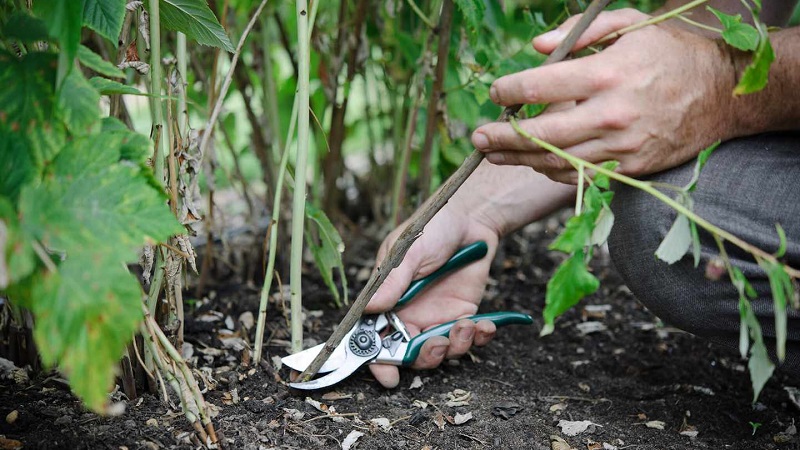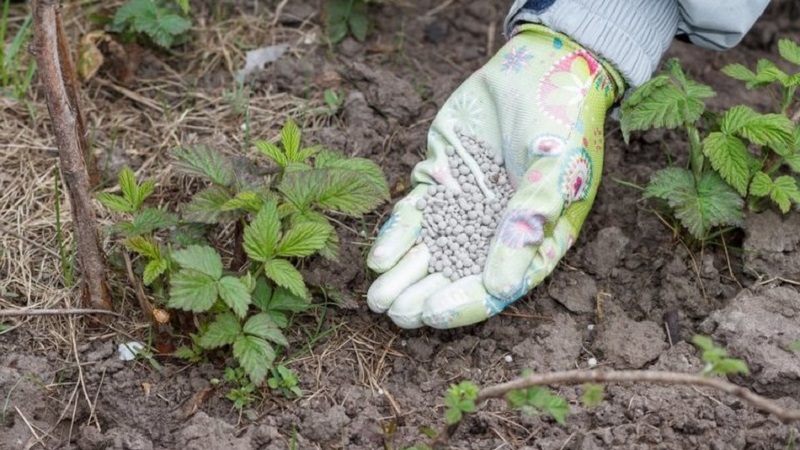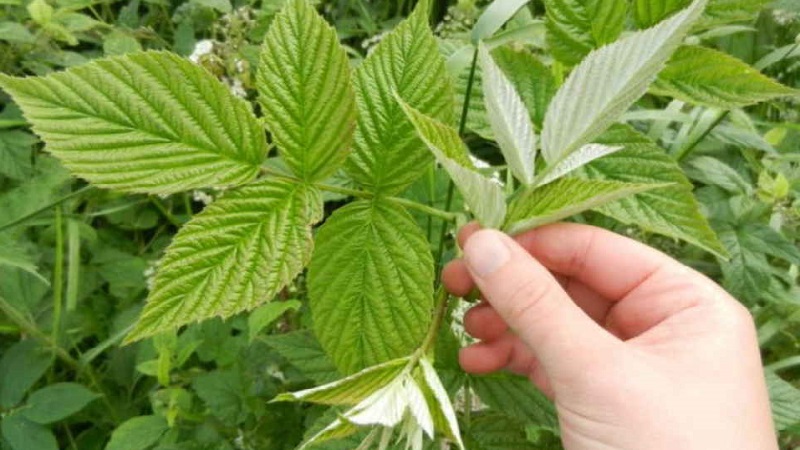Instructions for caring for raspberries in spring after winter and advice from experienced gardeners
A shoot on a raspberry bush lives for two years. The first year he is gaining strength, growing up. In the second year, it bears fruit and dies off, being replaced by a new shoot. The branches of the remontant variety bear fruit from the first year, but after the second season they also dry up. A raspberry tree untreated in spring is more often infected with pests, thickens and runs wild, spreads outside the garden. In the article we will tell you about the rules and nuances of caring for raspberries in spring after winter.
The content of the article
What care is required for raspberries in spring

From one bush of healthy, properly processed raspberries, up to 4 kg of harvest are harvested per season. Unkempt raspberries do not bloom so abundantly, their fruits become smaller.
What does she need
In the spring, to prepare the shrub for active growth, they carry out:
- pruning shoots;
- loosening the soil;
- watering;
- fertilization;
- mulching;
- treatment against pests and diseases;
- thinning.
Dates of spring procedures
Work begins when a stable temperature of + 5 ° C and above is established:
- immediately after the last snow melts, pruning is done, the bushes and soil under it are cleaned of old foliage, the first fertilizers are applied;
- when the buds begin to bloom, the branches are pruned a second time, after which the earth is loosened, weeded, fertilized and mulched;
- at the time of flowering, raspberries are fed again;
- as the soil dries up, the bushes are watered abundantly;
- closer to summer, when new shoots have appeared, the bush is thinned out.
Necessary spring activities to increase yields
Raspberry processing is carried out in stages, observing a certain sequence.
Taking shelter

When a positive daytime temperature is established, and frosts are not expected, the covering material is removed from the raspberries. The land is cleared of foliage and the remains of last year's mulch. If the bushes for the winter bent to the ground, untie and straighten them.
Pruning
At the first spring pruning remove old branches that have already borne fruit at the root. Cut off frozen, broken stems, weak shoots:
- if the bed is formed in the form of bushes, leave 6-8 healthy strong shoots per bush;
- if raspberries are planted in the form of a trench, choose 14-16 powerful branches per 1 m, the rest are removed.
The damaged tips are cut off to the first healthy kidney - the one that does not visually differ from the others.
Attention. When processing the plant, do not compact the ground around the bushes with their feet. Compacted soil limits the access of moisture and oxygen to the roots.
When leaves appear on the tops, the shoots are pinched 20-40 cm. The branch with the unripe upper part removed will begin to give strong lateral shoots.

Watering
Water the raspberries with the appearance of the first leaves. The soil is soaked abundantly, at the rate of 10 liters per bush. Such a measure will provide the earth with moisture under the root system and give it the opportunity to develop deeper. Repeat the procedure as the soil dries.
For repeated watering, the amount of water is reduced to 4 liters per bush. Moistening is continued until the shrub blooms.
Loosening
The root system of raspberries is located at a depth of 30 cm underground.The soil is loosened carefully, with a special hoe, to a depth of 10 cm. This improves the access of oxygen, moisture and fertilizers to the roots.
Feeding

The raspberry bush has been actively bearing fruit for 12 years. He draws out all useful microelements from the ground already in the first two years of life. To increase the yield, the soil is fed:
- The first dressing is applied when new shoots appear. During this period, the plant needs nitrogen. It helps to form strong greens. Nitrogen fertilizers are applied before flowering. Otherwise, the shoots will grow, stopping the formation of buds.
- Before flowering, when buds are just forming, potassium and phosphorus are added to the soil. These elements help to get large and ripe fruits. The amount of nitrogen is reduced.
- During the flowering period and the appearance of the first berries, the amount of potassium and phosphorus is increased, and nitrogen is completely excluded.
Mulching
Raspberries are mulched after fertilization at the moment when new shoots have reached 30-40 cm. Manure is added to the mulch to saturate the soil with nitrogen. The following are used as mulch:
- Twigs and chips from the compost heap. They cover the ground with a layer of 6-8 cm.
- Newspapers. Use both whole sheets and pieces of paper. They are laid in 4 layers and covered with earth.
- Straw manure. Pour in a layer of 5-7 cm.
- Husks of sunflower seeds. Layer thickness up to 5 cm.
- Peat, sawdust or hay.
Treatment against diseases and pests
Processing is carried out before the buds bloom. Raspberries are sprayed with copper-containing preparations. Copper sulfate, urea, or ammonia will do.
At the time of bud formation, re-processing is carried out. In this phase, biochemical solutions are allowed. Decoctions of wormwood, dill, marigolds are also considered effective. At the same time, the bases of the stems are watered with an aqueous suspension of ash and tobacco dust.
Processing with fire and boiling water
Scalding the branches with boiling water will help rid the plant of the larvae of many pests. The procedure begins when the snow has melted, but the buds are still dormant. Water is heated in a metal bucket to 70 ° C and poured into a watering can.
Water the branches only once to warm the buds, but not scald. Try not to hit the ground under the bush. A little boiling water will not hurt the ground, but a large amount will scald the roots.
Attention. Cut branches, foliage and last year's mulch create the right conditions for the pest larvae to overwinter. To protect the raspberry tree, the cuttings are taken out of the garden and burned.
Transfer

Plants are transplanted as needed, when the thickets have become too thick and the harvest is small. They also do this when the soil is depleted or for the reproduction of raspberry bushes.
The transplant is performed when the buds are swollen, but have not yet blossomed:
- Choose healthy bushes with a main stem thickness of more than 1 cm.
- Dig it around the bush, carefully remove it from the soil and divide it into parts.
- They are placed to the depth of the root collar in pre-prepared holes filled with fertilizers.
- Spread the roots, sprinkle with a mixture of equal parts of earth, sand and humus.
- They are tamped, watered, mulched.
- Cut off the stems, leaving 70 cm.
Read more about transplanting raspberries in spring in this article.
Do I need to dig
Raspberries love loose, moist soil. But digging up the ground under the bushes leads to damage to the root system. It is allowed to dig up the soil in the autumn and only between the rows of plants. In spring, shallow loosening is sufficient.
Thinning shoots
Thin raspberries when new shoots start to grow. Weak, dense stems and root shoots are cut as low as possible to the ground. Only replacement shoots are left.
Reference. The replacement shoot grows out of the root collar of the bush, it is strong and replaces the fruiting trunk. Due to such sprouts, the plant rejuvenates. Root shoots make their way at a distance from the mother plant, forming a new young bush, but takes away strength from the main one.
Thinning prevents thickening and shading of the beds.
Features of care depending on the region

The middle strip of Russia is ideal for growing raspberries on climatic conditions. Spring treatments in this region are standard and begin in late March - early April.
In the south of Russia, processing of raspberries begins in March. Winter is milder here than in other regions, so raspberries do not require winter shelter and bending.
In Siberia and the Urals, where the climate is more severe, plantings are opened at night temperatures of 0 ° C. This will help the soil warm up faster. Bushes do not untie. Shrub care begins in April, when the daytime temperature reaches + 8 ° C.
Spring planting of raspberries

Seedlings with an open root system are easier to adapt when planting in spring. Potted bushes, the roots of which are covered with soil, are planted in spring, autumn and even summer by transshipment.
Separate trench and cluster methods landing... With a trench, a long furrow is dug 40 cm wide and deep.With a bush, holes are 40 by 40 cm.A 70 cm is left between the bushes, and 1.5 m between the rows.
For the raspberry tree, choose a sunny place with moist, but not swampy soil. If the soil in the area is dry, the bushes require frequent watering. Trenches are dug from north to south. Due to this orientation relative to the sun, the plant will be exposed to the light throughout the day.
Important. Youngsters are not planted in the place where the raspberry or strawberry garden was previously located for 6 years. Old shoots will prevent young ones from growing. In addition, diseases and pests common to these two berries are still preserved in the soil.
When and how to plant
Seedlings with open roots are placed in the ground until the buds swell. For this:
- In a sunny place, dig a trench or hole.
- If the soil is dry, water the planting site abundantly.
- Filled with organic fertilizers.
- A seedling is placed in the hole so that the root collar is at ground level, and sprinkled with a fertile layer.
- Fertilize, water and mulch.
Tips from seasoned gardeners

Summer residents who get a consistently high yield from their raspberry plant recommend following some rules:
- The bushes are tied to a specially installed fence. Such a measure will increase the yield due to the penetration of light over the entire length of the bush.
- Raspberries especially need watering at the time of flowering and berry formation. Abundant watering during this period will increase the yield by about three times. In the ripening phase, watering is reduced to a minimum or excluded so that the fruits do not turn out to be watery and tasteless.
- Pest control is important. They are tenacious and destroy most of the trunks.
- Transfer required when new powerful shoots of replacement are not enough for a large harvest. The root system has grown over the entire area of the raspberry tree, and it has ceased to rejuvenate.
- Top dressing applied after watering. It will improve the permeability of the soil.
- Fresh fertile soil is regularly added under the bushes. It is prepared in advance from a mixture of peat, sand, manure and earth and left for a year in a dry place.
- Between the rows of raspberries, it is advisable to lay a path of planks so that the soil is always moderately moist and not tamped.
Common mistakes
As a result of these errors, the quality and quantity of the crop suffers:
- Carrying out pruning after the start of sap flow. As a result, healthy, ready-to-open kidneys are damaged.
- Incorrect sequence of actions. For example, fertilizing after mulching will not be beneficial, since the protective layer will not allow the fertilizing to penetrate to the roots.
- Insufficient thinning of the plantation. Excess thin shoots do not yield crops, shade fruiting trunks and draw out nutrients.
- Loosening too deep. Breaking the soil layer deeper than 10 cm will damage the root system.
Conclusion
The main spring care for raspberries is pruning and removing old foliage, watering and sanitizing.Thin as new shoots grow throughout the garden period. With proper care, the fruits will become larger and the harvest will be plentiful.